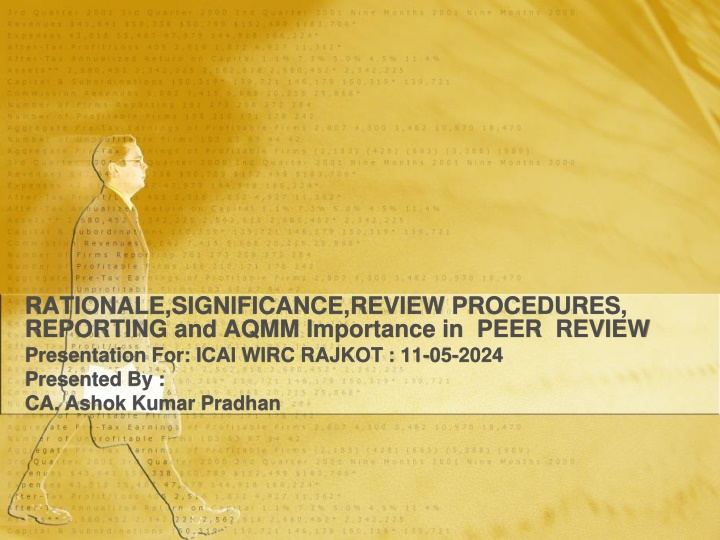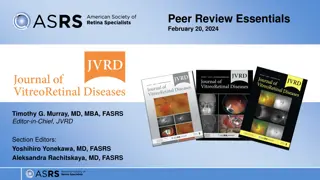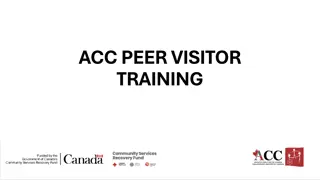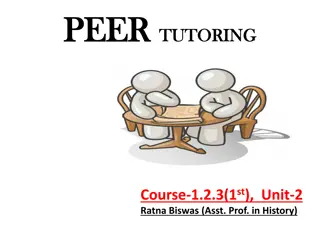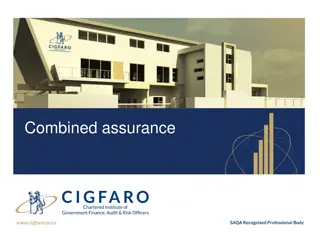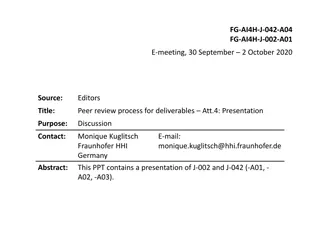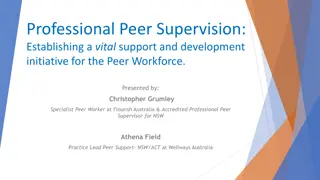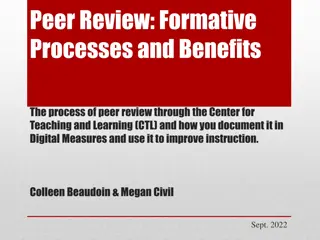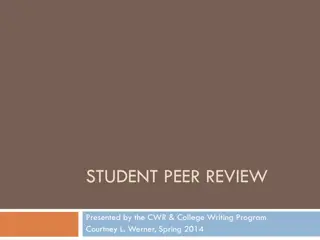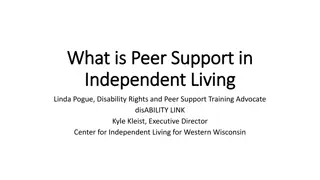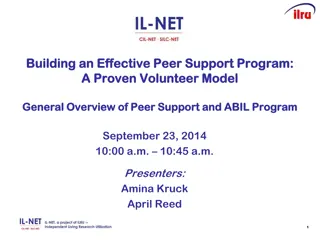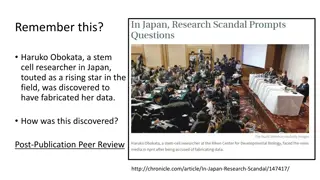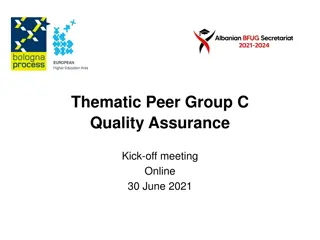Importance of Peer Review in Enhancing Assurance Services and Regulatory Compliance
Peer review plays a crucial role in strengthening public confidence in financial reporting, ensuring audit effectiveness, and maintaining quality across auditing firms. It helps bridge the gap between expected and actual service quality, restores public trust, and supports regulatory adherence. The current peer review system in India, overseen by the Institute of Chartered Accountants, focuses on defining objectives, powers, eligibility criteria, and procedural frameworks. It aims to enhance the overall quality and consistency of auditing services while providing guidance for improvement.
Download Presentation

Please find below an Image/Link to download the presentation.
The content on the website is provided AS IS for your information and personal use only. It may not be sold, licensed, or shared on other websites without obtaining consent from the author.If you encounter any issues during the download, it is possible that the publisher has removed the file from their server.
You are allowed to download the files provided on this website for personal or commercial use, subject to the condition that they are used lawfully. All files are the property of their respective owners.
The content on the website is provided AS IS for your information and personal use only. It may not be sold, licensed, or shared on other websites without obtaining consent from the author.
E N D
Presentation Transcript
RATIONALE,SIGNIFICANCE,REVIEW PROCEDURES, REPORTING and AQMM Importance in PEER REVIEW Presentation For: ICAI WIRC RAJKOT : 11-05-2024 Presented By : CA. Ashok Kumar Pradhan
OVERVIEW RATIONALE OF PEER REVIEW At Profession s Level: To strengthen public confidence in financial reporting and effectiveness of audit process. To increase the basis of reliance placed by users of financial statements for economic decision making. To ensure better quality and consistency in auditing services across cross-section of auditing firms.
OVERVIEW RATIONALE OF PEER REVIEW At Firm s Level : To maintain assurance services To provide guidance to members to improve their performance To ensure adherence to various statutory and other regulatory requirements and enhance quality of
NEED FOR PEER REVIEW Expectation of service Receiver to receive quality service Gap between minimum quality of service and actual service rendered. Failure of Few service providers. Restoration of public confidence
Present Peer Review System In India Supervisor Within Institute of Chartered Accountants of India Chinese Wall between process and Disciplinary Mechanism has been removed as statement on Peer Review(Disciplinary action if deficiency in services of Auditor is found.) Audit of accounts after 1st April 2002 only covered Peer Reviewers are Individual Members of the Institute. Peer Review per the revised
Paras in Statement on Peer Review 1.Introduction 2.Objectives 3.Definitions 4.Authority of the statement on Peer review 5.Powers of the Council 6. Powers of Peer Review Board 7.Scope of Peer Review 8. Functions of the Board 9. Compliance with the Statement on Peer Review 10. Eligibility to be a Reviewer 11. Practice Units subject to review
Paras in Statement on Peer Review 12. Obligation of the practice Unit/ Peer Reviewer 13. Periodicity of Peer Review 14. Cost of Peer Review 15. Review Framework 16. Referral of Disputes and Appeals 17. Immunity 18. Confidentiality 19. Procedural departures 20. New Changes
NEWCHANGES To Replace Replace Statement ( ( wef wef 01.10.2022 01.10.2022 ) ) Guidelines Guidelines To Statement on on Peer Peer Review Review
NEWCHANGES To Replace Replace Statement Guidelines Guidelines To Statement wef wef 01.10.2022 01.10.2022 Validity of Certificate 3 years for all firms; unless the Board otherwise decides for certain category of firms
CHANGES in To Replace Replace Statement wef wef 01.10.2022 01.10.2022 Guidelines Guidelines To Statement
Peer Review Future Applicability Phase I: Statutory Audit of Enterprises whose Equity or Debt are Listed wef 01.04.22 Phase II: Applicable wef 01.07.2024 Statutory Audit of Unlisted Enterprises whose Paid-up Capital not less than 500 cr; or Turnover not. less than 1000 cr; or Outstanding loan/debenture/deposit not less than 500 cr as at 31stMarch of immediate preceding year. Firms having 5 or more partners - For these Practice Units, there is a pre-requisite of having Peer Review Certificate before accepting any Statutory audit. Practice Units which accept Statutory audits on or before 31.03.2024 should ensure that they have a valid Peer Review Certificate at the time of signing.
Peer Review Future Applicability Phase III: Statutory Audit of Enterprises who have Raised funds of over 50 cr or which are covered under Public Interest Entity wef 01.01.25 Firms having 4 or more partners -wef 01.01.25 Firms conducting audit of branches of Public Sector Banks wef 01.04.25 Firms having 3 or more partners -wef 01.04.25
Objective of Peer Review The purpose of the Peer Review statement is to provide a framework for, planning, performing, reporting and administration of the Peer Review process. Peer Review process is intended to Review the quality control framework of the Practice Unit as well as proper application of such control frameworks across engagement samples selected for Review. The statement provides the terms of reference of such Reviews and the roles and responsibilities of the parties concerned. and consistent
Scope of Peer Review The Review shall cover: Compliance with Technical, Professional and Ethical Standards: Quality of reporting. iii. Systems and procedures for carrying out assurance services. iv. Training Programmes articled and audit assistants) concerned with assurance functions, including availability of appropriate infrastructure. i. ii. for staff (including
Scope of Peer Review Compliance guidelines issued by the Council to the Members, including Fees to be charged, Number of audits undertaken, register for Assurance Engagements conducted during the year and such other related records. vi. Compliance with directions guidelines issued by the Council. with directions and / or v. and / or
SIGNIFICANCE OF PEER REVIEW There is a statutory requirement by SEBI whereby a listed Company s Statutory Audit and Limited Review can be done only by Peer Reviewed Audit firm. SEBI has also mandated that any report or prospectus issued by any Corporate has to be given only by a Peer Reviewed Audit firm.
SIGNIFICANCE OF PEER REVIEW Comptroller and Auditor General of India (C&AG) upto 25 Additional Points for Peer Reviewed Firms. Comptroller & Auditor General (CAG) has mandated that only Peer Reviewed CA Firms will be given PSU and Government Company Audits. Multiple Empanelment Form (MEF) cannot be completed without giving Peer Review Certificate Date. Thus Bank Audits eligibility depends on Peer Review.
SIGNIFICANCE OF PEER REVIEW The issuance of an unqualified Peer Review Report will avoid Disciplinary action by ICAI. The Peer Review could reduce the vulnerability under RTI Act and Consumer Protection Act. This Review would definitely lead to knowledge improvement for both the Reviewed Firm as well as the Reviewer.
SIGNIFICANCE OF PEER REVIEW The Peer Review would definitely lead to experience sharing between the Peer Reviewer and the Peer Reviewed. This may lead to exchange of best practices. The Peer Review brings fellow professionals in close contact with each other. This results in networking and recognition of mutual strengths for collaboration.
Scope of Peer Review System & Procedure carried out during the period under review. Check Records for three completed financial years (records required to be maintained for 7 years by a PU) Focus on: Compliance with Technical Standards Compliance with directions/guidelines of council for Members and Articles Quality of Reporting Office Systems and Procedures Training Program for Staff (including Articled and Audit assistants) Appropriate infrastructure for assurance services
Sample Selection Criteria Representative of total population Highest Turnover At least 5 samples in total (in case less than 5 then 100% population) must be selected from the category Statutory Audit of Listed entities, Central/ State Public Sector Undertakings and Central Cooperative Societies At least 1 sample each from CSA audit of Banks and Insurance Company, (if any). CSA will be substituted by SBAs in case PU does not undertake CSA. Sample must include `each type of assurance engagement (Statutory / Internal / Concurrent / Tax / GST etc.) Sample from Service provided through tender
Sample Selection Criteria Sample must from the assurance clients which contribute 15% or more to the total revenue of the firm Sample must be selected from each of the locations where the PU is rendering Assurance services. However, in case branch has a listed client, then that is mandatorily required to be included in the sample There must be at least one sample from assurance service rendered by each partner of the PU. Sample must be picked from each year under review. Sample must necessarily include those clients in respect of whom advisory has been issued by QRB, FRRB or any regulator ( Ref: Quest Part B II-Ethics, S.No 14).
Sample Selection Criteria Other points to select sample representative: Original equipment manufacturer (OEM) Unique Product Line (UPL) Highly customised product (HCP) Highest fee.
Questionnaire .. PART A 1. Disciplinary proceedings if any 2. Client obtained through the process of tendering 3. Details of the assurance clients ( S.No 23 ) in format for Head office and branch separately for the period of review year wise Below format for reference. *Serial No A to K ( Total 11 categories + Tender ) **Type of engagement (1) Central Statutory Audit (CSA), (2) Statutory Audit (SA), (3) Tax Audit (TA), (4) Internal Audit (IA), (5) GST Audit (6) Others
Questionnaire .. PART A Period Covered: details of assurance clients where report / certificate has been signed during the period under review i.e. means three financial years preceding the year in which the Practice Unit is selected or such other period or any period as may be prescribed by Board for conducting a Peer Review in a specific case. Part A Firm information, 22 points, with Annexure A for List of attestation Services
Questionnaire .. PART A Part B on General Controls based on SQC with VI sub parts: Leadership Responsibilities For Quality Within The Firm ( 10 points ) Ethical Requirements ( 15 points ) Acceptance and Continuance of Client Relationships and Specific Engagements (7 points) Human Resources ( 10 points ) Engagement Performance (20 points ) Monitoring ( 6 points ) Part C on AQMM with 3 Sections: Practice Management Human Resource Management Practice Management Strategic/Functional
Audit Audit Quality Quality Maturity 1.0 1.0 (AQMM Maturity Model (AQMMv1.0) Model - - Version v1.0) Version Evaluation Matrix To enable audit firms to self-evaluate their current level of: Audit Maturity Identify areas where competencies are good or lacking Develop a road map for upgrading to a higher level of maturity AQMM v1.0 would be recommendatory with exceptions. Level 1 depicts that the firm is very nascent, Level 4 indicates that the firm has made significant adoption of standards and procedures.
AUDIT QUALITY MATURITY MODEL (AQMM) Self Evaluation of Firm VeryNasty Immediate StepsRequired Upto25%in eachSection Level1Firm Firmmade someProgress Upto25%to 50%ineach Section Level2Firm Firmmade substantial progress Upto50%to 75%ineach Section Level3Firm Upto75%to 100%ineach Section Significant adoptionof Standardsand Procedures Level4Firm
AUDIT QUALITY MATURITY MODEL (AQMM) Self Evaluation of Firm
Limitations of Peer Review Review would not necessarily disclose all weaknesses in compliance of technical standards. Any system of quality control has certain inherent limitations Departure from system may occur & may not be detected ( Collusion, Human Error, Sample Size, Management Override etc.. ) Projection of any evaluation of system of quality control to future periods is subject to risk.
RATIONALE AND SIGNIFICANCE OF PEER REVIEW Thank You. Email Id : akpradhan@cvk-ca.com Phones : 022-24468717; 2446 6139; 2445 1488. Presented By Presented By Ashok Kumar Ashok Kumar Pradhan Pradhan
